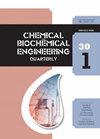Comparison of Degradation of Lignin-containing Wastewaters in the Presence of Different Microbial Consortia
IF 0.9
4区 生物学
Q4 BIOTECHNOLOGY & APPLIED MICROBIOLOGY
引用次数: 0
Abstract
Lignin-containing wastewater treatment by different microbial consortia were studied in this research. The special microbial consortia (J-6 and J-1) obtained from decayed wooden relics were selected. The bacteria of original microbial consortium J-6 mainly included Shinella , Cupriavidus and Bosea . The bacteria of original microbial consortium J-1 mainly included Serratia and Yersinia . The fungi of J-6 and J-1 were dominated by Saccharomycetales. The performances of two microbial consortia in wastewater treatment were compared, and the changes in community structure were analyzed to study the relationship between microbial consortium structure and degradation efficiency. For the treatment of model Chinese medicine wastewater, the optimal degradation conditions were treatment temperature of 30 °C, initial pH of 7, dissolved oxygen of 2 mg L –1 , and treatment time of 96 h. The COD (Chemical Oxygen Demand) removal efficiency reached 95.25 % by J-1. For the treatment of model papermaking wastewater, the optimal degradation conditions were treatment temperature of 30 °C, pH of 5, dissolved oxygen of 3 mg L –1 , nitrogen source concentration of 0.1 g L –1 , and treatment time of 120 h. The COD removal efficiency reached 86.8 % by J-6. Bacteria played a significant role in the degradation of lignin-containing wastewater, and the bacterial consortium abundance may promote the degradation of organic substances in the wastewater. The dominant strains were different in Chinese medicine wastewater and paper-making wastewater systems. The correlation between microorganisms and the difference in the abundance of bacteria groups may be the reason for the different performances of the two microbial consortia in treating different lignin-containing wastewaters.不同菌群对含木质素废水的降解效果比较
研究了不同菌群对含木质素废水的处理效果。从腐烂的木质文物中获得特殊的微生物群落(J-6和J-1)。J-6原菌群细菌主要有Shinella、Cupriavidus和Bosea。病原菌J-1主要为沙雷氏菌和耶尔森氏菌。J-6和J-1真菌以saccharomycetale为主。比较了两种微生物群落在污水处理中的表现,分析了群落结构的变化,研究了微生物群落结构与降解效率的关系。对于模型中药废水,最佳降解条件为处理温度为30℃,初始pH为7,溶解氧为2 mg L -1,处理时间为96 h, J-1对COD(化学需氧量)的去除率达到95.25%。对于模型造纸废水,最佳降解条件为处理温度30℃、pH 5、溶解氧3 mg L -1、氮源浓度0.1 g L -1、处理时间120 h, J-6对COD的去除率达到86.8%。细菌在含木质素废水的降解中发挥了重要作用,菌群丰度可以促进废水中有机物的降解。在中药废水和造纸废水系统中,优势菌群存在差异。微生物之间的相关性和菌群丰度的差异可能是两种微生物群落在处理不同含木质素废水时表现不同的原因。
本文章由计算机程序翻译,如有差异,请以英文原文为准。
求助全文
约1分钟内获得全文
求助全文
来源期刊
CiteScore
2.70
自引率
6.70%
发文量
23
审稿时长
>12 weeks
期刊介绍:
The journal provides an international forum for presentation of original papers, reviews and discussions on the latest developments in chemical and biochemical engineering. The scope of the journal is wide and no limitation except relevance to chemical and biochemical engineering is required.
The criteria for the acceptance of papers are originality, quality of work and clarity of style. All papers are subject to reviewing by at least two international experts (blind peer review).
The language of the journal is English. Final versions of the manuscripts are subject to metric (SI units and IUPAC recommendations) and English language reviewing.
Editor and Editorial board make the final decision about acceptance of a manuscript.
Page charges are excluded.

 求助内容:
求助内容: 应助结果提醒方式:
应助结果提醒方式:


